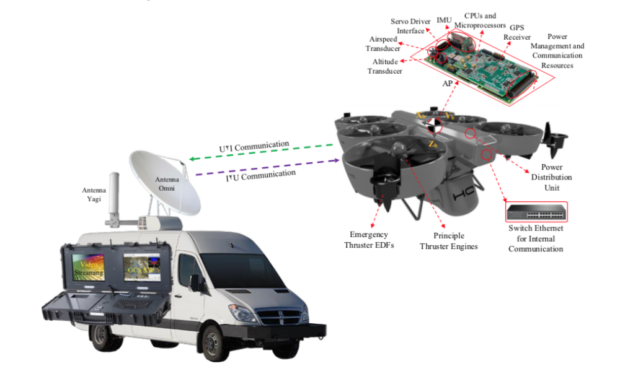A team of Spanish researchers has published an 11-page study which addresses theoretical and practical controller platforms, offering novel solutions to the vital control issues that arise when combined with communication problems in the case of multi-UAVs for remote sensing operations.
Recently,various research studies have been developed to address communication sensors for Unmanned Aerial Systems (UASs). In particular, when pondering control difficulties, communication is a crucial component.
To this end, strengthening a control algorithm with redundant linking sensors ensures the overall system works accurately, even if some components fail. This paper proposes a novel approach to integrate several sensors and actuators for a heavy Unmanned Aerial Vehicle (UAV).
Additionally, a cutting-edge Robust Thrust Vectoring Control (RTVC) technique is designed to control various communicative modules during a flying mission and converge the attitude system to stability.
The results of the study demonstrate that even though RTVC is not frequently utilized, it works as well as cascade PID controllers, particularly for multi-rotors with mounted flaps, and could be perfectly functional in UAVs powered by thermal engines to increase the autonomy since the propellers cannot be used as controller surfaces.Conclusions and Future Work
This research addresses theoretical and practical controller platforms, offering novel solutions to the vital control issues that arise when combined with communication problems in the case of multi-UAVs for remote sensing operations. In particular, a multi-ducted fan (MDF) is designed based on several considerations, including long flight endurance and transporting heavy payloads, and to maintain more stability, a hexa-duct casing is developed. Then, utilizing the aerodynamics results, a suitable duct geometry concentrating on the exhaust area is exploited to optimize the number of blades in each propeller, which leads to better performance. The presented system is powered by thermal and redundant electrical engines, in which the thermal ones generate the required thrust during the flight, and the electrical ducted fans (EDFs) survive the MDF in case of emergency.
Furthermore, in order to overcome the uncertainties of the thermal thrusters, a novel robust controller based on thrust vectoring control (TVC) is presented. The results demonstrate an acceptable performance for long-range flights when compared to a tuned cascade PID performance for an ideal case, but improving the TVC’s theory and practical application is required for the design of industrial platforms.
Meanwhile, a redundant communication system is carried out to support flights with medium and long ranges. Future works will include the analysis of the sensors and the useful outcomes of the enhanced system.
This research was supported by the European Commission-funded program WILDHOPPER, under H2020 Grant Agreement 880642.
The complete 11-page paper can be accessed here.
Source: MDPI

